Filter cassettes are underground structures used to treat wastewater in systems autonomous sewerage. In accordance with regulatory documents, the height of the underground filter cassette must be at least 250 mm.
Reinforced concrete slabs are used to cover the structure, concrete blocks, brick.
The filter cassettes have a crushed stone base covered with coarse sand as a cleaning load. The area of such a load is calculated based on the indicators of an average flow volume of 60 liters / sq. meter per day.
Cassettes or wells
The filter cartridges can be replaced with a well. In fact, they are completely interchangeable, but the cassette still has whole line benefits. One of key benefits cassettes - not a significant depth. Replacing the filter well with a cassette is clearly shown in cases where the groundwater level in the area is high. The sand filling of the cassette must be at least one meter above the groundwater level.
In cases where for some reason this cannot be achieved, it is possible to increase the area of the cassette or refuse to install the pits, replacing them with an increased sprinkling of filter material.
Wastewater treatment plant with diversion Wastewater into the body of water
At impervious soils with low filtering capacity, autonomous sewage systems are used with subsequent disposal of wastewater into natural reservoirs. Such systems can also be installed on normally filtering soils, if it is not possible to divert the sewerage system to a sufficient distance from the drinking well. This will protect drinking water from contamination. Experts also note that the discharge of even treated wastewater into the soil is not advisable, especially if the sewerage system serves several houses, for example, a cottage village.
Sewerage systems with the discharge of wastewater into a reservoir do not differ in the way they operate from networks with soil discharge. The only difference between these systems is that when discharged into the ground, water immediately after passing through underground filtering facilities enters the soil, and when discharged into a reservoir, devices are added to the system to collect and drain already purified water.
Sand and gravel filters
Regardless of where the purified water is discharged, a septic tank must be equipped in front of underground filtration systems. In fact, it is a sump, where preliminary purification of water from mechanical impurities is carried out. Instead of a septic tank, you can use aeration treatment facilities. Their use allows to achieve the concentration of suspended particles in the runoff at the level of 10-15 mg/liter, which corresponds to the indicators of wastewater treatment using underground filtration systems, so in some cases it is possible to refuse to install them.
The sand and gravel filter system includes a filter bed and a drainage network. During its arrangement, the bottom of the pit, designed with a slight slope in the central part, is covered with gravel, crushed stone, sintered slag to a height of about 100 mm. A drainage network with a collector pipe and catchment pipes is laid on this layer. The pipeline is also covered with gravel or slag to a height of up to 100 mm. The use of sand and gravel filters allows the treatment of effluent with a higher volume of water flow. They are great for organization. sewer network for several houses, for example, in cottage settlements.
The area of the sand and gravel filter is calculated based on the placement of the pipeline, taking into account the distance between the pipes of about 0.5 meters. The length of the pipeline is determined based on the average indicators of the design load - 100 l / day per one running meter. At the beginning of the collector pipe, a ventilation riser must be installed, the height of which must exceed the ground by at least 700 mm.
When arranging a sand and gravel filter, it is necessary to provide a sanitary zone of at least 8 meters to the building. Otherwise, water will get into ground floor or basement.
Filter trenches
The design of the filter trench is similar to sand and gravel filters, but unlike them, it has a linear placement. At its core, the trench and the filter differ only in size and shape. Sanitary zone must also be at least 8 meters.
Water drainage
Water drainage in such sewerage systems, as already noted, is carried out in a natural reservoir. It can be organized by gravity, or first water is collected in a storage tank, after which it is pumped out using pumping equipment. The choice of one or another method of water drainage depends on the characteristics of the terrain. Disinfection of sewage is carried out using chlorine cartridges. It is also very important to provide for measures to prevent erosion of the coast at the point of discharge. This can be achieved by strengthening the soil with concrete slabs.
This article discusses the last three common methods for final post-treatment of wastewater drained from an equipped septic tank.
Sand and gravel filters
Sand and gravel filters are used on soils with poor filtration properties (for example, clay). The main elements of this kind of filters are irrigation and drainage networks, as well as filter media.
First, a pit is dug under the filter, so that its bottom is located approximately 1.5 m below the location of the dosing chamber or the outlet pipe of the septic tank. The base of the pit is arranged with a slope towards the central part. The slope is about 3 cm per meter. The bottom is covered with a layer of gravel, blast-furnace slag or crushed stone with a fraction size of 15-30 mm, on which a drainage network is placed. The drainage network is built from a central pipe with a diameter of 12-15 cm (the so-called collector) and drainage pipes 10 cm. in diameter. Drainage pipes can be plastic with side holes or asbestos-cement with cuts. Such pipes are attached to the collector using sewer tees made of plastic or cast iron.
The collected drainage network is covered with gravel, crushed stone or slag, while the following backfilling order is observed:
Then, after thorough compaction, a layer of gravel, crushed stone or slag with a fraction of 15-30 mm is laid. An irrigation network is laid on top of it, which is arranged by analogy with a drainage network. The irrigation network is covered with a 50 mm gravel layer, on top of which a roofing material or hydroisol layer and a clay layer are laid, forming a clay castle. In conclusion, the pit is covered with soil.
The area of the resulting filter is determined based on the length of the irrigation pipes, taking into account the distance between them of 50 cm. The required pipe length is determined according to the rule: 1 meter of pipe per 100 liters of wastewater per day (or 150 liters per day when cleaning "gray" drains). Thus, with a flow volume of 1 m 3 / day (1000 liters), the length of the irrigation pipe system will be 10 m. If the length of the collector is 2.5 m, then the required length of irrigation pipes can be achieved using five pairs of branches of 1 meter each . In this case, the filter area will be 2.5x2 m.
The drainage pipe tray must be at least 1 meter above the groundwater level. If ground water located high, the filter can be placed in the backfill (if necessary, sewage pumping can be arranged). If the filter is installed in the bedding, it is overlaid with a layer waterproofing material, then they are poured with a 50-60 cm layer of slag and a layer of soil 20 cm high.
The water purified by the filter enters the well, to which the end of the collector is connected drainage system. In accordance with the requirements of the sanitary and epidemiological surveillance authorities, purified water can be subjected to additional disinfection using a chlorine cartridge. With a well volume of 0.5 m 3, one chlorine cartridge provides disinfection for a month.
It is worth remembering that the constant discharge of water containing high residual concentrations of chlorine into a reservoir can have a negative impact on aquatic life. In this regard, chlorination of already treated wastewater is carried out only in agreement with the sanitary inspection in conditions of increased epidemiological danger.
Removal of wastewater from the collector well after their cleaning and neutralization can be carried out by gravity or using special pumping equipment.
Filter trenches
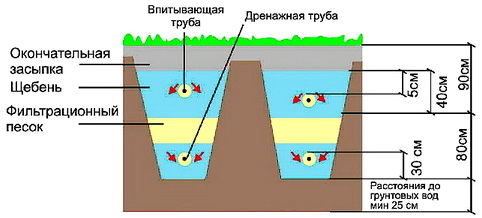
The elements of the filter trench are the same as those of the sand and gravel filter. But, unlike the latter, the filter trench has a linear structure. Its length can reach 30 m with a width of 0.5 m.
With a wastewater volume of up to 0.5 m 3 per day (average volume for a family of 2-3 people), a sufficient length of the filter trench is 5 m, at 1 m 3 - 10 m. houses, the quality of cleaning is similar to that of a sand and gravel filter.
The filter cassette is used for wastewater treatment when groundwater is deposited on high level.
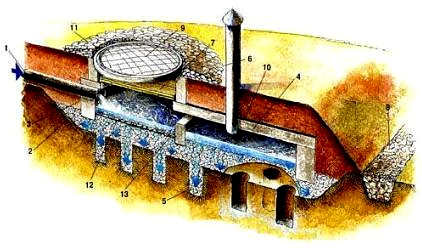
The filter cassette is arranged in a rectangular area, the area of which in the case of loamy soils is 10-12 m 2, in the case of clay soils - 15-18 m 2. The surface of the site should be located at a level approximately 1 m above the groundwater level (if necessary, a backfill is formed for the filtration cassette). A layer of gravel, crushed stone or slag with a fraction size of 2-10 mm is laid on a leveled and planned site, the height of the layer should be 20-30 cm.
Supports are installed in two rows along one of the sides of the site (which is longer). The distance between the supports is about 1 m. Floors are organized on top of the supports. Various improvised materials are used as floors, such as logs, defective concrete products, slats, poles, slabs, and so on. On top of the ceiling and on its sides, a 25-50 cm layer of gravel, crushed stone or slag is covered, then covered with a layer of waterproofing material, which in turn is covered with a meter-long layer of soil.
After passing through the septic tank, wastewater is pumped through a pressure pipe into the space under the ceiling by means of a pump. To reduce the area occupied by the filtration cassette, it is possible to place filter wells in its base, which use the same material as in the base of the cassette. The diameter of the wells can be 20-30 cm, the depth is 70 cm, such wells are located at a distance of 50 cm from each other.
The collection of filtered wastewater is carried out using a drainage tray filled with filter material ( approximate dimensions trays are 20x30 cm.). Removal of treated wastewater into the reservoir is carried out using another similar drainage tray.
The removal of sewage from a private house implies the presence of a well or a container where these drains will be collected. Since the discharge of wastewater into the environment is prohibited by construction and sanitary standards, you will have to think over a system for cleaning and draining sewers. The best option a system of drainage wells, filtration cassettes, fields in which water is cleaned and sucked into the soil is considered. Methods and methods of wastewater treatment directly depend on the height of the rising groundwater and soil characteristics.
How does a septic tank work?
- anaerobic fermentation in a sealed container of the wastewater itself, in which fractionation occurs, the liquid subsequently enters the post-treatment, and the dense fraction settles in the septic tank. During anaerobic fermentation, a large amount of methane gas is produced, which is removed from the septic tank using a special pipe.
- Filtration and purification wastewater, the choice of method depends on the depth of groundwater, the nature of the soil, as well as the relief features of the site.
Septic tanks can be built from various materials: bricks, concrete rings, sheet metal tanks and plastic containers. All of them are dug into the ground and equipped with a pipeline through which water is drained from the septic tank. At the same time, home-made septic tanks need to ensure the tightness of the walls, additional treatment against corrosion and active organic compounds, as well as the watertightness of the seams between the material.
Septic tank options
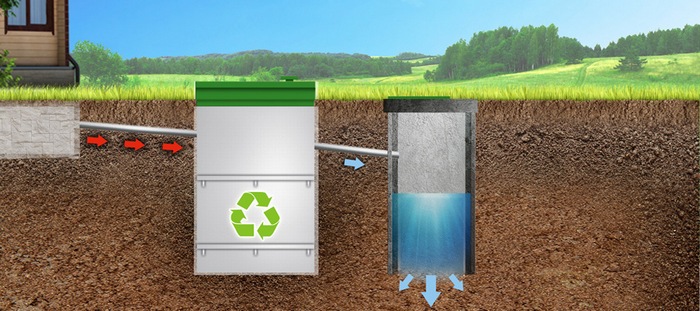
Before choosing the method that you will use to purify and drain water from the septic tank, you need to accurately measure at what depth the groundwater occurs on the site, and also determine what kind of soil will be under the septic tank.
Choices:
- At the surface level of groundwater occurrence, dispersion or filtration fields are used, from which water is discharged using trenches with a filter layer of sand, gravel, crushed stone. Thus, a sufficient degree of purification is achieved to divert water into the ground.
- With a close occurrence of groundwater, drainage or filter wells are used, they have a leaky bottom, on which a filter layer of sand, gravel, crushed stone is poured. After purification, the water goes into the ground.
- A filter cartridge for a septic tank, which is used to organize the discharge of wastewater on clay and loamy soils with poor permeability.
- After the septic tank, the water is discharged into a storm sewer or drainage ditch.
- With a forced selection pump, water is discharged into a reservoir, rain or sewer ditch.
- Water is discharged into a storage tank, from which crops are then irrigated.
Filter fields
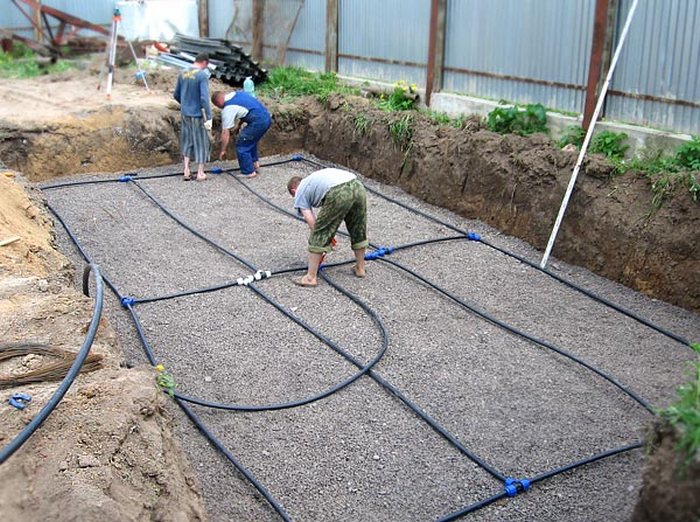
An option for post-treatment and discharge of liquid from a septic tank is a filtration field. This a good option cleaning drain water from a septic tank, if the groundwater level is less than 1.5 meters. Water, seeping through the drainage layer, will go into the soil. These fields are set up as follows:
- Such a field should be located at the maximum distance from the house, sources of drinking water, fruit trees and shrubs.
- The drainage layer system in the filtration fields has been functioning normally for quite a long time, about 7 years, in the future the drainage pad will have to be replaced so as not to pollute the groundwater.
- The distance between the parallel pipes of the drainage system is at least 2 meters, and the length of one pipe is about 20 meters.
- The depth of the drainage layers must be below the freezing level of the soil, otherwise in winter the water impregnating the layers may freeze.
- A filter layer is poured at the bottom of the trench in the following sequence: a layer of sand with a thickness of 10 cm, then a layer of gravel or crushed stone with a thickness of 60 cm.
- On a layer of gravel or sand, special drainage pipes with holes are laid, through which water is drained from the septic tank.
- The pipes are covered with a layer of rubble and insulated with a special material - a film that will protect the system from freezing in winter.
- Soil is poured on top of the filtration ditch.
- At in large numbers wastewater filtration fields can be equipped with an additional tank, where wastewater from the drainage system will be collected. Such a homemade pond can be planted with willows or birches, they have an increased need for a daily dose of water, so they will help drain the tank faster.
Storm sewer
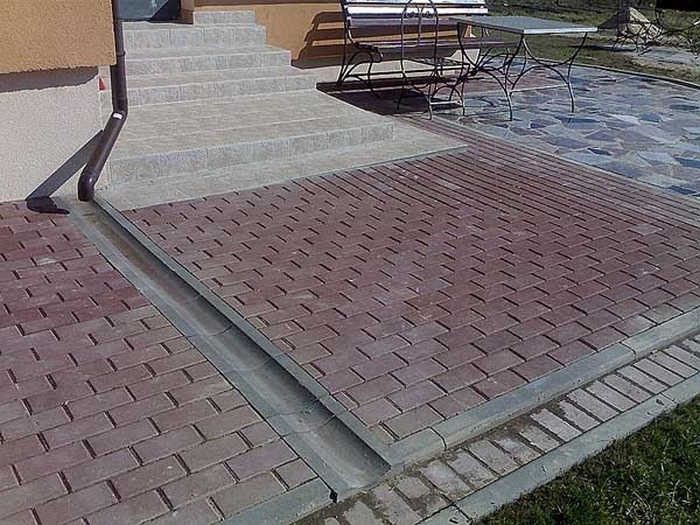
This type of water drainage from a septic tank is a system of ditches, which is arranged using drainage trays or pipes of sufficient diameter. Water in such a system is discharged by gravity. It is mounted if it is not possible to arrange a drainage well near the septic tank. Here, first of all, the angle of inclination of the drainage system is important, since it ensures the drainage of water. If the slope of the system is insufficient, use a drain pump.
At the end point storm sewer install a drainage well-water collector, where water will be collected. Here, the water will undergo additional purification and go into the soil.
The system is quite simple in execution and operation, does not need cleaning or replacement of the drainage layer and is used most often on clay soils.
drainage well
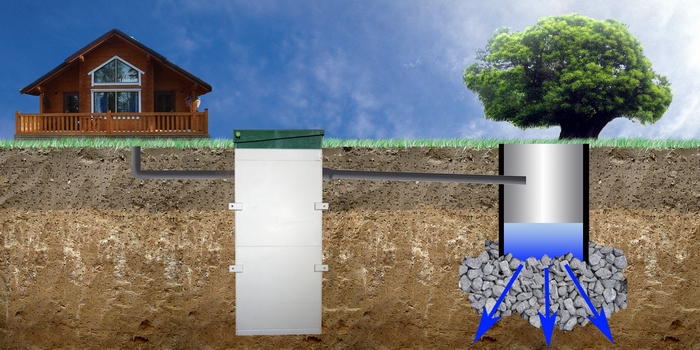
A drainage or filter well is not only a water collector, but also additional system water filtration. The water drained from the septic tank is finally cleaned in the well and goes into the ground.
- For a drainage well, soil with good permeable characteristics is considered ideal, it allows water not to stagnate. Clay and loam, which almost do not let moisture through, is an unsuitable basis for a drainage well.
- When equipping a well, its bottom must be at least half a meter above the groundwater level. The depth of soil freezing is also taken into account, this is important for the normal functioning of the system in winter.
- The farther the filter well is located from the septic tank, the better. The optimal distance starts from 20 meters, the length of the drain pipe should be slightly longer.
- The walls can be laid out of red brick, stone, concrete rings, even old car tires. The main rule is that there should be drainage holes up to 10 cm in size in the walls. It is better to arrange them in a checkerboard pattern.
- The dimensions of standard drainage wells are from 2 meters in diameter and 3 meters deep. The shape can be any - square or round.
- The drainage well is supplied with a ventilation pipe, it should protrude above the surface of the earth, into which the well is dug by about a meter. Such a pipe provides the removal of accumulated gases and vapors.
- The filter bottom is covered with crushed stone, gravel, slag or small pebbles. Layer height from 30 cm to a meter.
- From above the filter well is closed with a lid.
Such a well can retain its filtering capacity long time, up to 10 years. After that, you will need to come up with a way to clean and restore the well.
Accumulative water collector
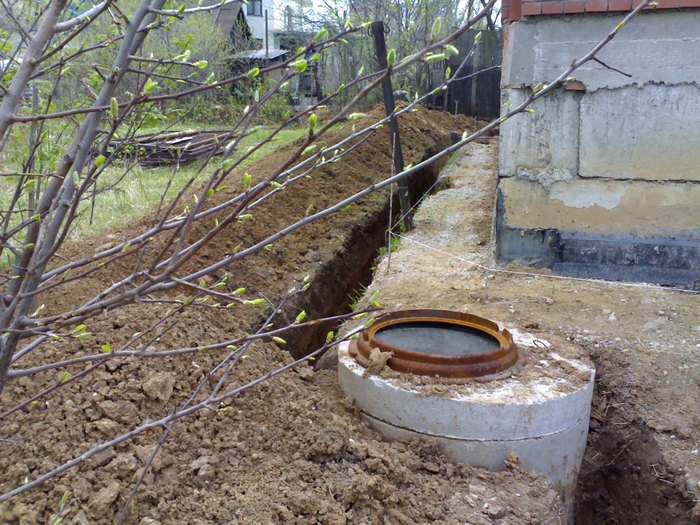
The accumulative type of well is used if there is a need for irrigation, and also if there is nowhere to put wastewater, since there is no possibility to use other types of treatment.
Storage wells are sealed containers made of plastic, metal or concrete rings, where the water drained from the septic tank goes through the pipe. Plastic containers are the most popular, as they are airtight, resistant to corrosion and aggressive chemical compounds, do not need additional processing, have a long service life, and are also relatively light in weight. Therefore, they are easy to install in a permanent place.
Iron containers, as a rule, need an additional internal coating with paint or any other layer that protects against corrosion. They have a serious weight, during installation it is often necessary to use additional equipment, such as a crane. Before installation, it is recommended to treat the seams with a special sealant.
Concrete rings for such wells are almost never used - the seams must be processed too tightly, and the bottom is carefully concreted so that it does not let in, but accumulates moisture. At the same time, concrete is rapidly destroyed under the influence of water, so such a tank is not the most durable.
Installation of this type of well involves the following steps:
- The installation of a storage well is carried out below the level of the septic tank, that is, so that water flows into it by gravity.
- The optimal distance from the septic tank to the storage tank starts from 6 meters. The pipe through which the liquid will be drained from the septic tank must be straight, as the pipeline turns can become clogged.
- Before installing the tank, carry out preparatory work- dig a hole with walls half a meter larger than the container.
- A layer of sand is used as the base for the tank. If groundwater is close to the surface, then it is worth doing more solid foundation, for example, a concrete foundation to eliminate further subsidence of the structure.
- The tank is installed evenly so that there are no distortions of the structure, a drain is connected and covered with sand from all sides, leaving a hole on the surface for cleaning the tank. A thick layer of sand protects well from freezing in winter.
- The tank must be equipped with an alarm system in case of overflow.
- Water intake from such a tank can be carried out by a surface drainage pump.
filter cassette
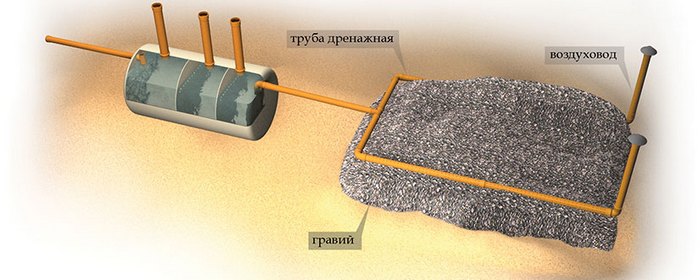
The filter cassette is a filter for wastewater from a septic tank on a plot of up to 20 sq.m. The groundwater level must lie at least one meter from the surface of the filter bottom.
- To mount the cassette, they level the site, and then dig a rectangular hole half a meter deep.
- The pit is filled with sand, blocks 30 cm high are laid around the perimeter. The resulting pit is covered with a layer of rubble.
- On top of the blocks, concrete or other supports are installed, which are covered with waterproofing and a layer of soil.
- The pipeline from the septic tank carries out a conclusion under supporting structure and connects to a plastic filter cassette located on a layer of gravel.
- After filtration, the water is absorbed into the soil.
winter problems
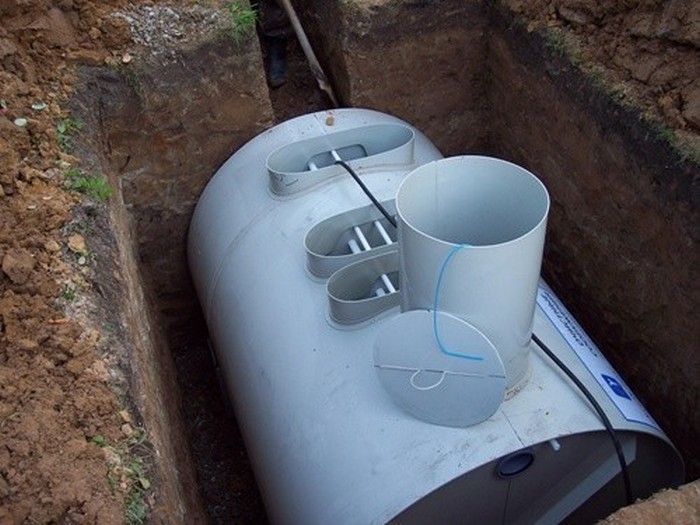
When choosing the option of discharging or removing wastewater from a septic tank, it is necessary to foresee problems that may arise in winter. A significant and prolonged decrease in temperatures forces us to take some measures to ensure protection against freezing of sewage.
- When installing a discharge system, accumulation, pipelines and other systems, you need to take into account the depth of soil freezing in your area and bury them below. Thus, you will provide natural protection of pipelines from freezing.
- Ensure the mandatory slope of the drain pipe from the septic tank, as a pipe in which water does not stagnate or even minimal amount, is always dry. In the absence of water, there is nothing to freeze through.
- In general, the slope of the pipe, even with the forced discharge of wastewater by the pump, is a guarantee against freezing.
- An additionally insulated pipeline drain will be a guarantee against freezing of the pipe in winter.
- For filter fields or cassettes, waterproofing and additional thermal insulation are provided with special materials that will minimize the freezing of pipes. The pipe slope rule works in this case as well.
System selection

When choosing a wastewater treatment system from a septic tank, it is worth considering not only your capabilities, but also carefully read the permissible sanitary standards and rules. Otherwise, with a spontaneous discharge of wastewater into reservoirs and rain ditches, you may have trouble not only with your neighbors, but also with the law.
When installing and assembling a wastewater discharge system, the following parameters must be taken into account:
- To discharge wastewater into the environment, they must be pre-treated with special equipment;
- Do not discharge wastewater with bacterial contamination or organic compounds that can cause harm environment and sanitary background.
In addition, the conditions for the discharge of wastewater depend on the relief and size of the site, on the volume of wastewater from the septic tank, on the characteristics of the soil and the depth of groundwater. Additional type purification plant it is easy to determine, knowing what is the absorption capacity of the soil on your site, how far can you divert drain water from the house, what optimal system drainage is suitable for your site.
The filter cassette is an underground analogue of the filtration field, which is part of a complex of sewage treatment plants. It looks like a box without a bottom, crushed stone is poured instead. The purpose of this design is to eliminate the smell on the surface. It has good performance indicators at a high level of standing groundwater.
For light to medium loamy soils
Underground structure with a height of 250 mm and overlap. The cover is made from concrete slabs or other materials. The walls on which the structure rests are made of solid brick or concrete blocks. In light and medium loamy soils, under the entire area of the cassette, there is a base of crushed stone 100 mm thick, which is covered with coarse-grained sand of a fraction of 1-2 mm (150 mm). The area of the filter load is calculated based on the design load of 60 l/(m 2 /day). At the entrance to the sewage sewage of the cottage sewerage, crushed stone of a fraction of 20-40 mm is thrown into the filter cassette and a jet wall is built. When creating a flower bed or sports ground above the filter cassette, a ventilation pipe is installed without fail.
For heavy loamy soils
The overall design of the cassette does not change. In heavy loamy soils over the entire filtration area, it is planned to create pits filled with crushed stone (vertical or inclined recesses) with a diameter of 150-200 mm and a depth of 500 mm. The gap between them should be 500 mm. The pits are located at least 1 m from the groundwater level; in other cases, their installation is not possible. If the depth does not meet the requirements, they resort to increasing the area of the cassette or thickening the layer of dusting with filter material.
Many people use underground filtration fields, filter cassettes, and more to make a soil-treated septic tank. Each method is shown below.
The fields represent one big network, it includes a lot of things, for example, irrigation pipes. Specialists lay them to a certain depth, which, as a rule, is 0.5-1.2 meters. Be sure to consider how deep the soil freezes in winter (if we talk about Moscow, this is about one and a half meters). Depending on the region of residence, this value decreases or vice versa increases. Be sure to remember the fact that the distance from the pipe tray to groundwater should be at least a meter, but no less.
Filter fields can be a great replacement for a filter well, many users use them at the same time with each other. Among the people, this combination got its name - a lying well.
Irrigation pipes are laid in the form of small branches, their length from the distribution well is about twenty meters. A pipeline with a diameter of one hundred mm must be laid with a certain condition, namely, observing a slope of up to 0.005, it must be taken into account. Installation of distribution and irrigation pipelines is carried out from plastic or non-pressure pipes. It is believed that the installation of plastic pipes is much easier, as they are light and do not cause any difficulties. This is a big plus from an economic point of view.
In the place where the branches of the irrigation pipes are located, it is necessary to equip special manholes. At the branch point, it is necessary to provide grooves with a width of thirty mm, this is necessary so that the user can later adjust the damper.
1 - single-chamber septic tank; 2 - distribution well; 3 - irrigation pipes; 4 - ventilation pipes; 5 - two-chamber septic tank; 6.8 - ventilation risers; 7 - main pipeline
If someone wishes, he can completely abandon both distribution pipes and wells, and irrigation pipes must be placed in a fan, in particular, they must pass along the radius from the filtering well itself, and in this case it will be distribution.
Irrigation pipes, diameter is about one hundred mm, and holes are five mm, they are directed downward at an angle of about sixty degrees vertically, the arrangement is staggered, the distance between them is fifty mm. Then, under the pipe, a backfill is made of crushed stone or other similar material, its layer is two hundred mm, and the width is slightly more - two hundred and fifty mm. The pipe must be placed in the backfill by about half the diameter.
In sandy soils, one meter of load accounts for a load of thirty liters per day, if these are sandy loamy soils, then it decreases slightly and amounts to fifteen liters. Moreover, if your site has loamy soil, be sure to increase the layer of gravel, and also sprinkle it with sand. If neither one nor the other can be done for some reason, you need to lengthen the pipe.
In order to ensure the flow of air, special risers must be provided at the ends of the pipes, their diameter is one hundred mm, and the height is two thousand mm. Some users do, or rather plant, climbing plants, and you can also turn the riser into a kind of architectural element by adding something of art to it.
Sand and gravel filters
Filters can include certain elements. Unlike the previous type, filters can be used to service several cottages at the same time.
In order for the filter to be installed correctly, it is necessary to perform a number of works, slag, gravel or, for example, slag is laid out at the very bottom of the pit, the material must have a particle size of about thirty mm, but not less than fifteen mm, the height must be one hundred mm. It is necessary to lay a drainage network along it, which in turn consists of a central pipe. This includes the collector, and from it the openings of the drainage pipes. Asbestos-cement pipes must be provided with cuts on the side, their depth is twenty mm and a width of five mm, this must be done at a distance of one hundred mm. The holes, along with the cuts, must also be staggered in the same way.

1 - supply pipeline; 2 - distribution pipeline; 3 - irrigation pipes; 4 - ventilation riser; 5 - drainage pipes; 6 - collection pipeline; 7 - outlet pipeline; 8 - irrigation zone (rubble); 9 - drainage zone (rubble); 10 - crushed stone base; 11 - ventilation riser; 12 - ventilation riser of the drainage system; 13 - waterproofing (roofing material); 14 - clay castle; 15 - insulating sprinkling
Fill the drainage network with some material, for example, slag, its size is fifteen - thirty mm, and the height above the top of the pipes is one hundred mm. Then it is necessary to make a layer of the same material again, but only ten mm in size and one hundred mm high.
The already finished filtering well is covered from above with one layer of sand, in size it should not even exceed two mm.
After the filter layer of the biological treatment plant is laid out, proceed to laying out a layer of gravel, crushed stone, or, for example, slag, fifteen to thirty mm.
The required length for irrigation pipes must be determined based on the load per meter of pipe of about one hundred liters per day. Length drainage pipe can be defined in exactly the same way. At the very end of the drainage network collector, as well as at its very beginning, special ventilation risers must be installed, their diameter is one hundred mm and the height is seven hundred mm, all this is measured based on the distance above the ground.
There must be a certain distance from groundwater to the tray, experts say that the minimum value is one meter. If the ground water level is too high, then a filter can be installed in the bed.
Consider how far your installation is from residential buildings, it is approximately 8 meters, this data must be clarified with a specialist.
Filter trenches
The laying of filter trenches in the biological treatment plant follows the same principle as described above, but the irrigation pipes are placed linearly, and their length can reach up to thirty meters.
Be sure to take into account the fact how deep the trench will be loaded, it is about 0.8 meters, and the width of the trench is half a meter, the load per 0.1 m of pipes is seventy liters per day. There must be a certain distance to residential buildings, and, as a rule, it is eight meters, it must be observed for the safety of residents.

1 - coarse sand; 2 - irrigation pipe; 3 - backfill; 4 - ventilation risers; 5 - intermediate layer of sand; 6 - distribution layer of sand; 7 - lower drain; 8 - gravel backfill
filter cassette
After the distribution well is installed, load the filter well into it. Subsequently, it is used so that the drains can be pumped into the cassette. To install this cassette, first remove upper layer fertile soil. The site is carefully prepared, and it should be fifty cm larger than the cassette.
The depth of the pit should be about fifty cm, then it is filled with sand and carefully compacted. After that, concrete blocks must be placed around the entire perimeter of the site, they must be fixed to each other. You will get a kind of box that needs to be covered with gravel (take a small one), then a cassette is placed on it - infiltrates that have no bottom.

1 - sewage supply pipeline; 2 - filter base; 3 - supporting blocks made of concrete or reinforced concrete; 4 - reinforced concrete slab overlaps; 5 - filtration wells; 6 - ventilation riser; 7 - wooden cover; 8 - drainage tray; 9 - hatch; 10 - waterproofing; 11 - stone blind area; 12 - stone paving; 13 - cast iron hatch; 14 - jet wall
You need to bring a pipe or hose to the installed cassette, it is through it that drains will then flow, install a pipe for ventilation. Styrofoam is laid out on top of the installed cassette (it serves as a heater), pour soil about twenty cm, a little more, but not less.
Waste water that will flow into the space formed between the filter media and the filter will spread, and then be filtered and pass into the ground. In order for the filtration surface to be increased to the required size, one can consider the option with a well.
The size of the load fragment for the filter base should be calculated at about 2-10 mm - this is fine crushed stone, slag or other material.
Make paving from stone, its size should be equal to 60-100mm.
Storage septic tank
In the event that all the structures described above seem difficult to install to you, you can build a biological treatment plant.
The storage septic tank is a modern drain hole, it is completely sealed, and most importantly, it can be used near ponds or other water sources. Installation of the product is quite simple, the weight of the structure is small. You do not have to equip your site with infiltrates, or, for example, drainage wells. The operation of the biological treatment plant is not affected in any way by the level of groundwater.
Just like all facilities, the biological treatment plant is not without drawbacks - despite the fact that there is no wastewater treatment in the tank, they fill up very quickly, which means that you will have to call a special sewage truck.
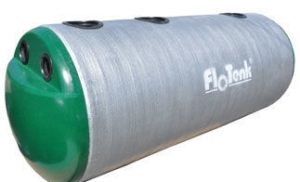
Accumulative septic tank Flotenk
If in your Vacation home if you come only for the summer and do not live in it at other times of the year, then this option will be the best. As a rule, such septic tanks are made of metal or plastic. Their volume is also different and, as a rule, it ranges from 1000 to 100,000 liters. The most popular factory brands are Flo Tenk - EN, Bars-N, Triton - N. Many residents prefer to make their own biological treatment plant.
Drives have a number of advantages and disadvantages. So, for example, the advantages of such installations include the following:
- Devices are completely safe for the environment around them - dirty water cannot seep into the ground.
- The septic tank will not suffer from the fact that water will be thrown into it in a large volley.
- Installation is simple and fast, it can be installed in any geological conditions.
- You can install a surface septic tank, that is, you do not have to make any complex work with earth.
- There is no need to install additional facilities for cleaning.
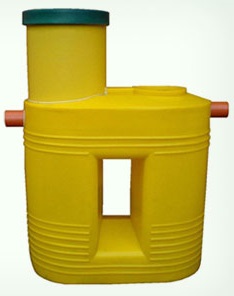
Station "Triton"
There is also a drawback to the biological treatment plant, but fortunately it is only one - the effluents will have to be pumped out regularly. Since calling a sewage truck every time is not a cheap pleasure, it is best to install septic tanks where water is consumed in small quantities.
If you don't know which biological treatment for sewerage it is better to choose, you can get advice from specialists, they will inspect your site and will definitely advise something.








